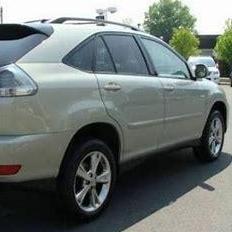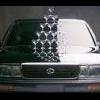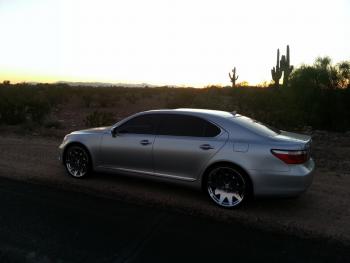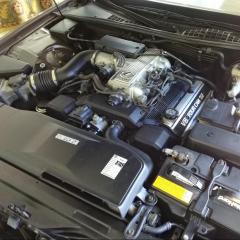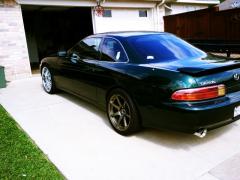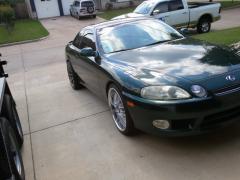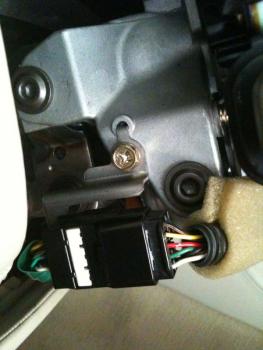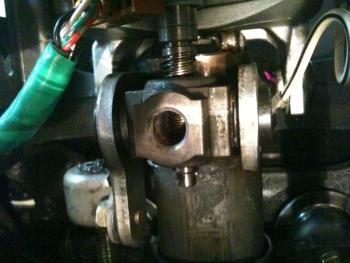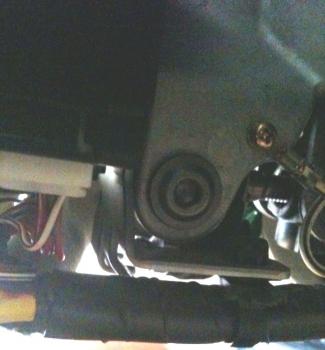Leaderboard
Popular Content
Showing content with the highest reputation since 02/28/2013 in all areas
-
Hello Everyone, I know IACV has been a huge topic on the forum and I have found various pictures in the RX forum and ES forum on the idle air control valve (IACV) or as others call it the idle speed control valve (ISC). However, I have not found a "step by step" posting to date which definitively shows how to clean this thing so that my car stops giving me idling problems. Symptoms I have had included: - low and rough idling that would cause the car engine to start shaking after starting the car - this eventually got worse to the point that when I start my car, it would not idle unless I gave it gas - idling problems for me tended to occur more often after my engine was warm or had been sitting in the sun I hope these series of postings help you fellow LOC members out there. You've certainly helped me in the past so here's my two cents at this common problem. Additionally, the instructions I give are the way in which I have cleaned it myself. As you go about and attempt this, you may find better ways to do so. Please add and refine my instructions/terminology as needed. I am not a professional. I've only changed my oil, air filters, and conducted minor maintenance previously. The bottom line is that if you have the right tools, you should be able to do this. This discovery/ cleaning took me about 2 hours to do cause I ran into problems and there were major steps left out in previous postings that I’ve encountered read. The next time I do this, I believe I can get this done in about an hour or less. Tools Needed: 1) Tightly fitting Philips Screw Driver 2) Carb cleaner that is O2 sensor safe (I've seen CRC. I used Valvoline Carb Cleaner) 3) Locking Grip Pliers (definitely helped me remove the factory tight screws) 4) Small brush for cleaning 5) Towels for cleaning 6) Pliers (help removed brackets holding the hoses) 7) Latex gloves helps with limit the messiness. * I used the same gasket and did not replace it. No problems found. 1) Remove the hose that comes from the engine/motor that connects to the air intake hoses.( Hose is below in red – we’ll refer to this as Hose A) When you pull back the rubber hose covering, you will see that a metal bracket is holding the hose pretty tightly in place. Use the pliers to clasps the two metal pieces together to loosen the bracket and pull the hose loose. You can also do this by hand if it’s easier for you. 2) Upon removing the hose, you will want to remove the two air intake hoses. Loosen the three screws above in green and remove the hose. Below is a picture of the intake hoses removed. 3)After removing the intake hoses, I opened the lid to the air filter and moved this to the side of the car to create more working room. I believe there are two clips on the right holding the lid in place. Just pop the two clips and move the cover to the side. I also took out the air filter and temporarily moved this to the side. 4)After removing the intake hose, the throttle body/IACV/black electric coil is revealed. At this point, I removed the black electric wire from the black coil. Once the electric wire is removed you can remove the black coil from the IACV by removing the two screws. Note, the screws are factory tight so use a tight fitting screw driver to remove the screws. One of my screws was partially stripped from the dealership’s work, so I had to resort to my locking grip pliers which helped out tremendously. After removing the two screws, the black electric piece pops right off. When the black electrical coil is removed from the IACV, it exposes a small pencil sized metal stud. You will also notice a washer that sits on this stud. Don’t lose this washer. Take it and put it aside so it doesn’t fall off when you continue on in the next steps. 5)Additionally, I removed the hose coming out of the IACV. We’ll call this Hose B. This hose can be removed in the same manner by clamping the bracket and pulling the hose out. You will see that the hose is removed below. Below are pictures of before and after. 6)Here is where the fun begins. I initially attempted to remove the four screws attached to the IACV at this point, but found that after an hour, this would be nearly impossible to remove considering the location of the screws were in an extremely tight spot. The only way I would be able to remove the IACV is to remove right throttle body. Not as tough as it sounds. Three screws need to be removed to accomplish this. Again, be careful when removing the screws. Also you will see I removed another electric plug and I also cut a tie wrap. Once you complete these steps, the throttle body/ IACV comes out pretty easily. Note when you remove the throttle body, there will be one LAST hose connected to the IACV. Be careful when you remove this hose as radiator fluid may spill. Some of my fluid spilled out so I just refilled my coolant after I was done. 7)Below is a picture of the bottom view of the IACV. You now can EASILY remove the four screws connecting the IACV to the throttle body . In the picture below, I have already removed one of the screws. Once the four screws are removed the IACV and throttle body separate. Now you can clean both of them with your carb cleaner, brush, towels, cotton swabs etc…. Picture here is before I the cleaning with all the muck inside Pictures after I cleaned the IACV and throttle body This last picture is the post throttle body cleaning 8) Once you are done cleaning, just put back the throttle body/iacv the same way you took it off, and put everything back in reverse order. Ensure the gasket is in place. Also, ensure you put the washer back on the electric coil. Make sure you place hose A & B back and ensure the electric plugs are back in their original position. Once these things are in place, then it's all about putting the air filter/hoses back and you are good to go. If you have lost any coolant, make sure you refill it to a safe level. After completing this cleaning, my car starts up without any problem and idles as if I just purchased the car brand new. Replacing this at a dealership would have costed me $300-400 easily. Let me know if you have any questions. Cheers (Also, I tried to post these as separate replys, but the software combined all my replies into a single reply and did not keep them separated) *Edited the posting to have the pictures follow step by step in sequential order*6 points
-
I was also sold this "invisible" ad on! Only to be told by the dealership "after" that it's not adjustable. So basically it's just a dimly lit thin strip! This should be included. Lexus could and should've done better!4 points
-
3 points
-
Hi. Some friends of mine suggested that I should post this here for more people to see. Hopefully it'll help people for years to come. You will need: About 50 bucks budget for the balljoint rod and the pipe clamp. Height sensor with bracket. 10mm wrench Washers that fit 10mm/M6 bolts. 10mm/M6 nuts Some smaller (8mm wrench) I own a 2001 LS430. The height sensor control arm's slider has rusted and become damaged over the last 19 or so years. The ball joint rod to the height sensor has also seized too. The height adjustment rod there in the red was seized, and the height slider in the blue was badly corroded and broken off. Rather than buy an entire control arm (green) this is an alterative method to repair it The arm is ~26mm in diameter. Buy yourself one of these pipe clamps in 26mm diameter. Or make one. Shouldn't be expensive. The hole needs to fit a M6/10mm bolt. Grind off the remnants of that slider from the control arm, and slide the pipe clamp over, and put your 10mm/M6 bolt and nut through and secure it in place where the slider used to be. Rather than using the control arm as a slider, we can instead use a sliding ball joint rod such as this one; This is a 220 320 00 32 from Mercedes - a height adjustment rod with a 8mm locking and a 10mm/M6 ball joint bolt. You can pick one up off eBay for cheap. Or find some other M6/10mm adjustable ball joint rod. Look at the diagram and try to imagine it in your head. This is what your bracket and rod/clamps should look like. One day I might snap a picture of what my repair looks like, but I hope you can make out what I mean via the diagram. This repair should be very easy. Maybe some sanding/grinding and surface preperation. The clamp will hold on tight and is easy to replace. The adjustable link rod will last longer and allow for easy adjustment, and less risk of corrosion damage. Hope this helps. This is a fairly easy job and took me less than 2 or so hours to do.3 points
-
Did I mention this?..... I don't like the fact that our governments plan to force us to buy EVs. I wouldn't mind having one, as we already have solar panels and don't pay for electricity, but I think we should be able to choose what we drive (within reason).3 points
-
At the part store they run a load test on the battery that mimics a big draw. If it holds up to a certain voltage it means the battery itself is not weakened yet. As the battery ages it will weaken as in not be able to supply a given amount of cold cranking amps. When its cold the oil thickens some thereby making the engine have to work harder to rotate. Hence the term "cold" cranking amps. I'd say you should investigate why the check engine lamp is lighting up. It could be a sign of what is taking place to cause your car to struggle to crank over. The part store can often "read the code" and determine why the CEL is lighting. My gut tells me your voltage regulator in the alternator is hit and miss. A long time ago that was a little box on the fire wall or fender. These days they are inside of the alternator. It determines how much electricity goes to the engine to keep it running and to the battery to charge it. It only has to be off by a little to keep the engine running but not have extra to charge the battery. Another issue could be a parasitic drain. An out of the ordinary draw on the battery when the car isn't running. In my 04 GS 300 for example the CD changer kept trying to change discs and the seat memory kept activating. Now I could not hear the disc changer nor was the seat memory moving the seat, but they were drawing on the system leading to a weak or dead battery if I didn't drive the car every day. Yet another issue may be short trips don't allow the battery to charge enough. Example; start the car, drive to a store 10 minutes away, finish there, start car and drive 10 minutes to another store. Never giving the engine a good 30-45 minutes to charge the battery back up to the voltage used to start the car can also lead to the hard to crank or dead battery issue. Hope you find it soon and it's a cheap and easy fix.3 points
-
I just purchased a NX200T. During the test drive I did not realize the headrest was a little too far forward. It is sharply angled toward the driver at the top. I am on the shorter side at 5' 6 1/2" tall and have good posture. When I sit in the driver seat with good posture my head is pushed forward about 1/2". I have to lean the seat back so I am slouching to avoid neck discomfort. I asked my dealer, service center and the U.S. corporate office for advice. There was nothing they could do. Very disappointing. The worst part is that the headrest is available outside the US with adjustable forward and aft movement at 4 intervals. I asked a few after market car parts dealers for advice. I was told it is a common problem. I was given many solutions (get another brand car's headrest, cushions, heat the metal and bend the rods, padding, etc.). Some ideas were unsafe and of course illegal I thought. For now I put some 2" cushioning in the seat to bring the rest of the seat inline with the headrest. It is better but not quite there and makes my A/C venting fairly useless, & is a little dorky. After just having paid about 50K for the fully loaded car I want a professional solution to improve the headrest. So far I have not solved it. I am curious if anyone else has had this issue and solved it? Any advice is appreciated. I am 95% happy with the car/SUV and am looking for that last 5% of comfort/fit.3 points
-
No reason to upgrade, Those stock wheels are Classic on the SC 😉3 points
-
3 points
-
3 points
-
3 points
-
Purchase has been made!...I could not turn down the deal I got & the actual ES...2020 ES 350 'premium' with only 11k miles in Nebula Grey Pearl (windows are already tinted)....over 2 years of full factory warranty remaining; 1 owner, full service history & Lexus CPO. Our 'premium package' in Canada is equipped quite differently than our friends south of the border....with more features / standard equipment. Originally I wanted the UL package....but in these parts, they are very rare (I reached out to 17 Lexus dealers in a 400 mile radius of me...the UL units that are available are 5 to 6 k more & only about 20% are actually at Lexus dealers...the premium pkg checks 95% of the boxes I was looking for....as the expression goes 'don't look a gift horse in the mouth'. I literally have a 6 minute drive to work... I pick the car up this Saturday.3 points
-
I like it when I'm trimming a rose bush, grab one to place in a jar and while heading indoors the Mrs arrives from work so I hand her the rose. Or when I come from work and the dog greets me at the door, tail all wagging-like. And the parrot says "welcome home"…… Or when a nice breeze blows just as the grass cut chore is over and the Mrs brings out a tall glass of ice cold spring water. Or when a new baseball cap fits my noggin just right without adjusting it. Or I step on the bathroom scale expecting to have gained weight but the scale shows I actually lost a little. Or when my son and I went to do the first start after an engine swap, expecting a hard to start issue but ole bessy fires right up. Or when the lawnmover starts first pull……again. Or helping out old people. Or thanking a soldier/veteran. Or tipping the person at the toll booth. Yes I stop and pay in cash so I can do that. Or when the voicemail on your phone was not a robo-call and instead was a friend telling you "hello, here's my new phone number" Or when you sneeze and a perfect stranger says "bless you". Life is short. But smiling makes you live longer. Trouble with being dead is it lasts so long.3 points
-
The cost of dental work, especially deep cleaning by laser and periodontal surgery, but also including implants.3 points
-
That's the view when I pull into the driveway after work. Unseen in the photo is the dog wagging his tail "it's that guy, he's back, yay!!"3 points
-
Update: I think I have got it after all the work, time, and money spent. I started checking again I found an unbelievable vacuum leak around lower intake manifold. replace gasket today runs great thanks for all of the support. something that simple fix. when the engine was swap the starter was replaced. The gasket moved or something apparently cause a vacuum leak. I had no idea a vacuum leak could cause random misfires. I was sure it was an ignition problem.3 points
-
Hi all, I believe I have posted here before a long time ago with my old LS430 LEX, I now have a 2007 LS460L with 110K on it now. I have owned it for a few years now, since 65K miles, and recently I started having acceleration/hesitation problems. I did alot of research, and didn't find very many good answers. I did have the transmission and engine ECU update flashed, with some improvement, but after that didn't solve the problem, I was convinced it was the cylinder head replacement deal, which was way out of my budget with 5 kids....and I thought it was ridiculous that a flagship sedan would need that kind of serious motor work with just 100K on it. Anyway, my mechanic suggested BG 44K fuel system cleaner, NOT available at places like autozone. He sells it for $28 per can, but I found on Ebay for $16.75 and up with free ship. First and foremost, I ALWAYS used quality, premium gas (Shell V-Power or QT), and Techron additive from time to time, so I was super unconvinced about his recommendation. I had even listed my LS for sale, again, convinced that the motor had cylinder issues after reading blogs about LS460 acceleration issues. Also, for the record, I have NO affiliation with BG or anything like that. THIS STUFF WORKS! It truly fixed my hesitation problems, completely. I am no longer selling the car, and am happy again, as it accelerates like it is supposed to. Feel free to read many other peoples reviews on this stuff, its amazing and really seems to work. After i drove it to wrok (25 miles one way) I thought i felt a difference, by the drive home, I KNEW I felt the difference, after the full tank, i was truly smiling. I have ordered 4 more cans for my other vehicles and boat, and suggested it to my friend with a ISF, my brother with an SC430, and my buddy with a Vette. I guess these LS460 cars are just picky after a while and maybe the injectors get gummed up? I don't pretend to be a mechanic, again this was suggested by my Lexus mechanic, After alot of depressing research with no real answer, just wanted to share my experience with any other LS460 owners, as it is a beautiful car, and I was disappointed in what I was thinking the problems I had. It was the best $17 I have recently spent, and if you are having similar weak/lack of acceleration or hesitation issues, i would say TRY IT for less than $20. I believe you can go to BG's site and find a local dealer, again, not autozone or O'Reilly or anything like that, says professional use only lol. Also, need a funnel, comes in a coke can basically. Just my 2 cents, hoping to help out any other LS460 owners out there depressed about their car, it seems most people just said they'd trade it in and buy a new one, but I'm not that rich :)3 points
-
3 points
-
The Lexus brand cell phone that was a dealer installed option lowered the HVAC fan speed and muted the audio system while a call was in progress. I even connected an aftermarket Nokia CARK-91 phone system I installed in my second (2000) LS400 to mute the audio system but I didn't bother to connect it to lower the HVAC fan speed. Even when a Lexus phone system was never installed, corrosion of the factory installed cell phone harness in the trunk can cause HVAC and audio system issues.3 points
-
20 years ago I swapped a domain name for a Lexus. The love affair started and I am now on my 10th Lexus3 points
-
3 points
-
3 points
-
Here are a couple of tips I have picked up regarding maximizing fuel efficiency 1. Replace the spark plugs if you have not already, I prefer NGK Iridium plugs 2. Look for Cooper CS5 Grand Touring/Ultimate Touring tires, they are excellent for these cars 3. Use OVERDRIVE on the highway or at speeds in excess of 60 MPH (most say 40-50 MPH, but in my car I have observed minimal difference at those speeds). Note that you can use Overdrive at all speeds and it will keep the RPM's down but from what I have learned at slower speeds this translates to negligible fuel economy gains. 4. Set your ECT mode to NORMAL and not PWR 5. Keep the RPM's as low as possible aka don't floor it 6. Make sure your wheels are balanced and aligned properly and that your tires are also correctly inflated. 7. Mythbusters proved this, KEEP YOUR CAR CLEAN, it does SLIGHTLY affect gas mileage for the positive. 8. Turn off your A/C system if you want, it does affect gas mileage slightly, but its also a comfort, not really necessary unless you want to maximize fuel economy. 9. In reference to replacing the spark plugs, you may also want to consider replacing the ignition coil, distributor cap & rotor, and plug wires if they have not been replaced in quite some time as they can lose spark and cause poor performance, this would be within a general tune-up. 10. Replace the fuel filter, this is commonly missed on every car, and they get NASTY, unclean fuel = bad performance. Also consider getting a professional fuel service done on your car, this can help too, especially if it has not been done in some time.3 points
-
Folks, and Forum Admin, Please make a separate section on the Forum for 2016 RX models. THese have had major changes since 2015. The engine has been tweaked, there are scores of safety improvements and the look is way different. I am sure the issues will be different as well. So please rename the 2010-Present section to say 2010-2015 and keep it separate from 2016 onwards. Thanks.3 points
-
I can answer that. Those zany Brits particularly like "mark" designations: https://en.wikipedia.org/wiki/Mark_(designation Maybe it is a longing for Jaguar sedan series names. In the UK, the model year ranges of the LS400 are referenced thusly: Series 1, Mark 1 = 1990-1992 Series 1, Mark 2 = 1993-1994 Series 2, Mark 3 = 1995-1997 Series 2, Mark 4 = 1998-20003 points
-
Replaced the Y pipe. Almost one month and no more problems.3 points
-
okay guys, I am going to give you a very constructive advice on how to fix this problem.first remove the cluster and if you do not know how go to lexls.com and follow the instructions.then remove the face cover .first grap the tach needle gently and pull untill you hear a pop,again be gentle and do not ge scared.once you hear the pop move the needle clockwise untill it pops again then gently release it.now move the needle slowly counterclock till you sit it over the zero an on the dot and make sure that it sits right on the zero.to check your work move it gently say to the mark 3 then let go it should snap right back to zero,once you have accomplished this ,you are rock & roll baby.the same thing goes for speedometer.back light is not working change cap 212,after making sure your cathodes are okay meaning the bulbs.if not you can get them at a very good price from plano lexus,they are awsome as far as price goes.gas guage slow change cap 142.while you are at it change any bad or weak bulbs ,be the warning ones or the indicator ones such as shifter position.by the way guys the cluster lexus has on the first gen is the 1992,because the psb are so robust,where the 1993 and 1994 are made a little bit on the cheapy side.this job should take about an hour if you how to handle things.good luck and let me know. please make a donation to lexls.com,this guy is great.may god bless his soul.3 points
-
According to Car & Driver magazine, Side note: I have a Samsung 23 Ultra and would NEVER switch to an iphone. My night photos are amazing, I have up to 10X optical zoom, and my stylus can be used to: Remotely advance PowerPoint slides Remotely take photos and videos, up to 30 ft away Translate embedded languages Zoom in to very small text that cannot be pinch-screened Create instant hand-written notes and drawings alone or within photos. I am thoroughly spoiled!🙂2 points
-
Hi all, been the better part of a year since I had reason to pop onto the forums. This post isn't looking for help, but instead offering some friendly advice on doing this job in a different way than the service manual describes (especially for those with back issues like me, because this way, the alternator comes out the top). I recently had my alternator drop out on my '98 LS400 (1UZFE VVT motor), and although I have the service manual, I decided to follow a different path with removing my alternator, because the service manual calls for complete removal of the power steering pump, which I found unnecessary. Instead, I followed the following steps (photos to come at a later date to make it easier to follow along) Tools you'll need- One each 10, 12, and 14mm wrench and socket. (One stubby ratchet or short 12mm wrench will come in handy, but isn't absolutely necessary) also a few extensions. Optional but recommended- One fan clutch removal tool. I have found that this style works best. https://shop.advanceautoparts.com/p/product/22983568 If you don't use a specialty tool like this, you will need a second 12mm wrench. Also recommended is a flex-head ratchet 1. Disconnect negative cable from battery and set away from the terminal to prevent accidentally shorting your electrical system later. 2. Remove all intake ducting, up to the throttle body. There are several vacuum lines attached, as well as a PCC hose. There are also a few 10mm bolts securing the intake. 3. Remove the cooling fan and fan clutch. There are four 12mm nuts holding the fan clutch on the pulley, and this is where you will use the removal tool (if you have it) to make your life easier. You can get away without a specialty tool with loosening each nut by tightening another, and on the last nut, using the box end of a wrench to gain some leverage on a stud where the nut has already been removed. You can pull the fan clutch out the top without removing anything else, just be careful not to hit into the radiator and damage any fins. 4. Remove the serpentine/drive belt. A 14mm wrench on the tensioner, and to loosen the tensioner, you rotate it in the counterclockwise direction. Slip the belt off the idler pulley, and after releasing the tensioner, you can remove the belt. 5. Loosen your power steering pump and reservoir- three 10mm bolts secure the reservoir, and three 14mm nuts and bolts secure the pump. Two fasteners are hidden on the bottom side of the passenger side cylinder head, right towards the front. A flex head ratchet works wonders here, otherwise you'll need extensions to get them from underneath the vehicle. You'll be able to use a ratchet on all these bolts, but not the 14mm nut securing the pump from the front, because it's blocked by the power steering pulley. You will NOT need to remove any hoses, but you will need to flex the reservoir around a bit to shift the whole assembly forward a few inches. 6. Now that the power steering pump is out of the way (it doesn't need to go far, not even off the stud it's mounted on) this is where you'll break out your stubby ratchet/12mm wrench. It's a bit of a tight squeeze, but you should be able to reach down from the top and pull off the rubber boot covering the alternator lug and loosen the 12mm nut securing the charging cable. 7. Once the charging cable is off, remove the bolt and nut securing the alternator to the block (both are 14mm). Now you can shift the alternator forward and access the wiring plug in the back. It's a standard pinch-and-pull removal, but mine, with 25 years of age and gunk, was stuck on pretty well. The last thing to remove is a wiring loom bracket for the oxygen sensor plug. This can come off with some persuasion, but it's ultimately easier to cut the electrical tape securing the wire to the bracket and removing the bracket once the alternator has been removed. 8. Remove the alternator! With the power steering pump shifted forward, you will be able to pull the alternator forward and off the stud, then straight up and out the top, without spilling a drop of fluids. Re-installation steps and torque values will be added to this post at the same time photos are.2 points
-
Back again with photos. Full disclosure, some pulleys and wiring brackets are removed in the photos, you do not need to remove anything that hasn't been mentioned, they're just taken off to have a better line-of-sight for the camera. Installation is the reverse of removal, and everything slides together fairly nicely. 1. You'll start by sliding the alternator onto the stud, letting it hang. Don't slide it back until you've plugged in the connector on the back and slid the rubber boot over top. Next, you can shift it back further and get your charging cable attached. There was not torque spec in the manual (that I could find) but good practice is to tighten the nut for the charging cable until you can't move the cable side to side. Slide the boot over top of the charging cable after it has been secured. If you were able to disconnect the wiring bracket on the alternator, reconnect it. If you cut the tape, peel off the old tape and wrap new tape around the mount and harness. Next, slide in your bottom alternator bolt and hinge your alternator side to side, lightly pushing on the bottom bolt to find the threads. Once you have both the nut and bolt lightly seated, you can torque them both to 29 ft-lbf. This is what you should look like at this step. 2. Re-install your power steering pump. The pump will slide straight back, if you meet resistance, double check that your reservoir isn't caught on the cooling hoses attached to the coolant reservoir, and turn the body of the pump on the stud to make sure the mount isn't colliding with the cylinder head. The bolt holes are a bit tricky to find, but for reference, the top hole of the two is directly beneath the widest portion of the valve cover, pictured here: The lower bolt is tucked a bit further and just slightly towards the rear of the vehicle. Here's a photo of the mounting holes on a spare cylinder head I have on the bench: Once all three fasteners are lightly seated on the power steering pump, go ahead and tighten them up. The torque spec is 29 ft-lbf for the two bolts, and 32 ft-lbf for the nut on the front. Go ahead and secure the three bolts holding your pump reservoir in as well. If you're reading this guide ahead of time, the bolt holes are marked with a red "X". Make sure you don't miss the one hiding underneath the coolant feed line. 3. Re-install your belt and cooling fan/ fan clutch. Attached is a photo of the belt routing (you should also have the same routing diagram attached to your hood). Torque spec for the fan clutch nuts is 16 ft-lbf. When you install your belt, make sure it is sitting in the grooves properly by hand. If it is misaligned, it can jump off when you start the engine and damage components. 4. Install your air ducting and vacuum/vent hoses, and reconnect your battery cable. You'll need to go through and re-set your clock, radio presets, and memory seats, but other than that, your job is (almost) done! 5. Check your charging system Your alternator is installed, but verify your system is working before setting off down the road. With the engine running, you should have about 14 DC volts. Double-checking this now is the best way to keep from immediately getting stranded with a dead battery, and while you're checking it, you can listen for any abnormal sounds from your engine. Torque values: Alternator mounting nut and bolt: 29 ft-lbf Power steering bolts: 29 ft-lbf Power steering nut: 32 ft-lbf Fan clutch nuts: 16 ft-lbf2 points
-
My goodness. Haven't read all the back and forth, but 50 years plus of being a mechanic means you should RUN, or have it towed asap from the current shop. Reasons: No car in the history of the planet has 3 coils go bad all at once. Not possible to diagnose injectors unless they are pulled and flow tested. Head gasket problems are relatively easy to diagnose on the V6. Since head gaskets don't blow simultaneously, unless you SERIOUSLY overheated the old girl, the sparkplugs on either bank will be utterly absolutely clean, cleaner than the other bank. Really, the best way to QUICKLY check a bad head gasket is to smell the exhaust. A sweet smell, obvious as hell. Timing problems, more than likely. Car can easily be saved with a competent mechanic. Don't be afraid to pull out of the shop -- money spent is money gone. Which is why is use YELP, etc. Good luck.2 points
-
2 points
-
2 points
-
2 points
-
other then a RX300, 89 Foxbody Mustang, 85 Foxbody LTD, a F250 and a 1999 Mercury Mountaineer2 points
-
Since the beginning of ownership, 4 months ago, my Lexus has been showing lights on the dash for: VSC, have checked by dealer Check engine Traction control off I would scan my car with your normal scan tool and it would read "camshaft position A actuator circuit". I ended up replacing both the sensor and solenoid on bank A. Neither of those things fixed the issue. $700 later, I replaced the timing control motor. More power, no lights and no issues. Passed inspection.2 points
-
I just fixed my 97 es300 with same problem"s" . The only difference between mine and yours is, mine wouldn't rev past 2500 rpm once it warmed with no check engine light. I've replaced everything you've done and still same problem. so, I took out my cam and crank sensor out to see how bad the resistance are between the prongs and cam sensor was within spec but started to leak oil and the crank sensor reading was off the chart. I've replaced the cam sensor due to oil leak and crank sensor due to extremely high resistance and my engine runs and sounds new. I was just about to post my finding and came across your post. take your crank sensor out and look inside the 2 prongs to see any corrosion build up and check the resistance. I hope my nightmare of 3 weeks can help you out. cheers.2 points
-
Have you tried alternating (on/off) the "auto" feature? Does it affect the heat? When was the last time your heating system coil was flushed? There is a temperature control valve also. If you don't want to go to a Lexus dealer, find a good local independent mechanic.2 points
-
I had a common problem with my right rear door actuator. It kept getting weaker and weaker slowing down and eventually not working at all. I did a search on Lexus actuator on ebay and came up with an inexpensive universal actuator which you will see below in the installation instructions. When I opened up the panel in the door it seemed to be near impossible to install this new actuator in any way. After dinking around trying this or that. I decided I would attach the actuator rod to the manual locking cam lever on the old actuator to try and make the new actuator work. This requires leaving the old non functioning actuator and parts in place. 1. Drill a hole the same diameter as the new actuator rod in the wider part of the manual locking cam lever on the old actuator right next to the where the manual locking wire hooks up to the old actuator cam lever. 2. Cut the new actuator rod to fit your application. Bend the new actuator rod end the same way the manual locking wire is bent. Grind the rod end a little thinner as it is tight under the locking cam lever and it will rub on the housing otherwise. 3. Have the new actuator attached at the other end of the rod first. Attach the rod through the hole you made in the cam lever the same way as the manual locking wire is attached. 4. Reinstall the entire door locking mechanism back in the door leaving the actuator hanging out the access hole. 5. Attach the mounting strap to the new actuator using 2 long bolts place 2 spacers or multiple washers between the strap and the actuator this way you can put the actuator just inside the access hole in the door (spacing it carefully not to interfere with the power window) thus allowing you to screw the strap to the outer door panel. 6. You will need to cut a little of the white thin plastic protector shroud on the old actuator to make good clearance for the new actuator rod coming out through the door access hole. 7. Adjust the new actuator for locking and unlocking slack before fastening the mounting strap with screws to the door. 8. Splice the 2 new wires into the 2 larger wires coming off the old actuator (splice them in don't cut the old wires) (You may have to reverse the wires (before soldering or crimping) to make sure you have them unlocking & locking in sequence with the rest of the door locks) It actually works better than the original with shipping it costs less than 15.00 for the parts. I used lock washers on the bolts. It would probably be good to use locktight on all screws. I have no pictures, but If you read this carefully you know it can be done and is not very difficult. I haven't tried this on the front doors yet, but will eventually have to. I hope it goes as well for me... At least it wors for the back doors. Good Luck to you!... Indi2 points
-
Thanks for the posting! We always like new information. Paul2 points
-
2 points
-
I've had ongoing issues with the driver's side window going up when it's supposed to go down, down when it's supposed to go up, or not moving. I removed the power window switch (there's a clip under where the lock/unlock button is), unplugged the assembly and took it apart. The four small Phillips head screws holding the light-covered cover are the ones you remove. Then, you'll see the circuit board. There are two relays on that board. The larger one is in the driver's side window circuit. It is marked CR2-12v. That's the culprit. After much searching, I found it on line. I replaced the one in my 170,000 mile '01 RX-300, reassembled everything and the window now works perfectly. Finally!! BTW, I bought two relays if anyone needs one and can't find it on their own. What a PITA that window has been...2 points
-
Hi there. FYI, I just happen to have a complete set of (4) LEXUS OEM 18" alloy wheels, including (4) Top-Rated (and barely used) Michelin X-Ice Xi2 235/60R18 Snow Tires. The bad news (for me) is that shortly after we purchased them, we purchased a winter-home in extreme southern Texas = super poor planning on our part. The good news for you (or someone) is that I'm only asking $1350 for "this > $3000 package", as just one new wheel @ Lexus sells for > $500. And if you'd like to see some photo's of them, they're posted on Craigslist, or I can email some photo's to you. So if you're interested, please give me a call at 440-254-6504, which is in Northeast Ohio, east of Cleveland. Thank you. Dan.2 points
-
Just posted this the other day, and now I can't find it, so sorry for the repeat if it is posted elsewhere. I have a 2011 ES350 with 215/55 17 tires. Those are the only size tires the car can come with. I would like to go with a bigger tire to improve handling. To get the same diameter, I would need a 235/50 17, or a 235/45 18. Please let me know if going from the 215 stock tire to the 235 will fit properly on the ES350. I wouldn't think it would be a problem, but I am not sure sonce the factory does not offer a tire size option. Thanks all.2 points
-
Seriously the technicians at the Lexus dealership can't sit their butts down in your car and see if the heaters work?2 points
-
Hi Nate, welcome to the club.. do like Richard said and check out http://www.lexls.com/ and read up,2 points
-
Thanks tex2670. Did anyone mention what causes the problem? Mileage related? How many miles on your '07? Just curious, Just saw a post on ClubLexus today with a good explanation (thanks to solotex55 -- no relation):2 points
-
2 points
-
2 points
-
Folks TILT STEERING NOT OPERATING ON LS430 Just fixed mine tonight 02 LS430 Ultra. Tilt was inoperable and on lowest (and most inconvenient) setting. Took about 30 mins. 3 screws (1 bottom, 2 on front face of shroud that you must turn steering wheel 90 degrees each way to access) to remove shroud. Motor was stuck. Was making very quiet clicking noise when I tried the switch. On 02, the motor assembly is parallel and below the steering column shaft. 2 metric allen keys and the motor releases from the column in which the steering wheel can be now lifted up. This will allow the motor to be free to be manually spun and manipulated by hand to free up. There may be an E clip that is on the worm gear that may be very tight and jamming the motor. Once the motor is spun to free it's movement, you can disconnect the harness, spin the motor to get it free (gear may need to be lubricated), the motor can be repositioned in a manner to have the column tilted to the level desired. Once that's done, reassemble and enjoy. I snapped several photos that I'll included that will make it more easily to visualize. Studying it and determining the cause took about 1 hour. Once you know what you need to do, job should take appx 30 mins or less, assuming you have the correct tools and are mechanically inclined. This is the view from the left side of the column. Remove the gold colored hex head bolt which releases the harness. The black hex head screw to the lower right of that is the right motor captive screw to be removed. This is the view from the bottom. A black colored hex head cover screw which contains a small spring and guide has been removed. The worm gear (long straight expoosed screw like mechanism) is attached to the tilt motor. The E clip that was jamming the motor was located on the worm gear (motor is at the top of the photo, worm gear is attached to the shaft of the motor, E clip is located (removed in this photo) in the area just above where the gear threads begin. View from the right of the steering column. Black hex head screw in middle of photo is the right captive screw on the motor. Email or message me with questions. Best Rick2 points

